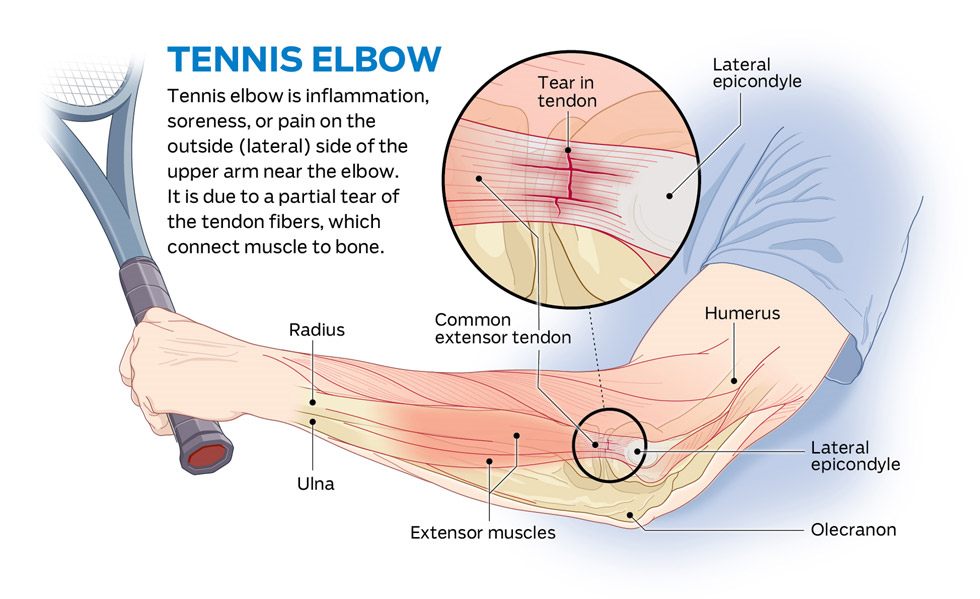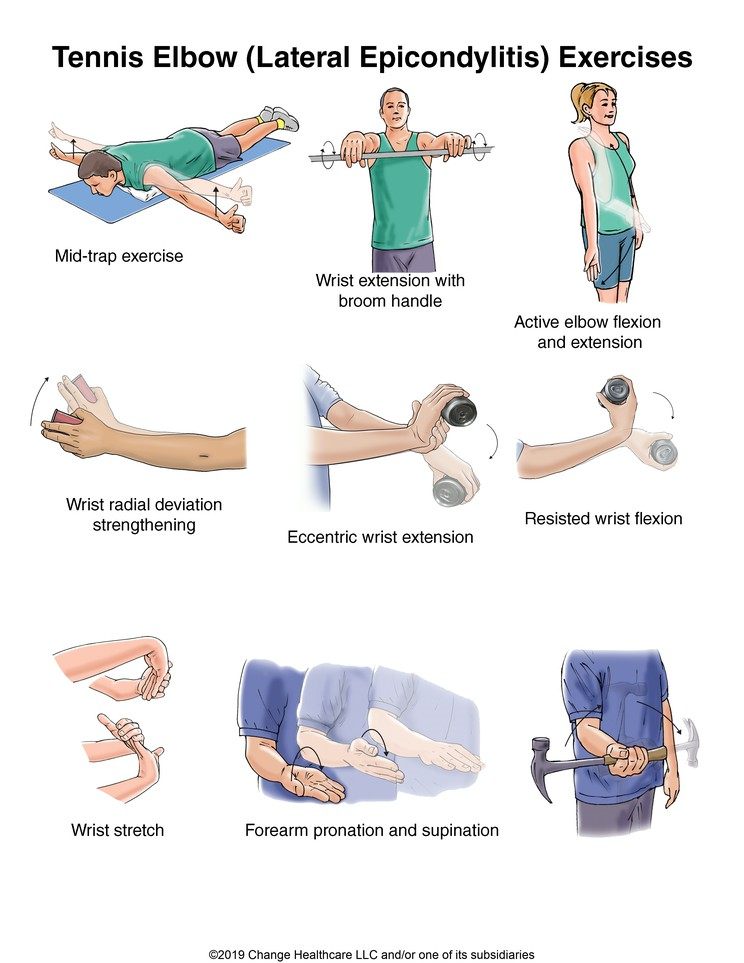What Is Tennis Elbow?
Tennis elbow is a repetitive strain injury, also known as lateral epicondylosis. Lateral refers to the outside part of the arm when standing upright with your arms at the sides. Tennis elbow is often referred to as outer (lateral) elbow pain or inside (medial) elbow pain but often originates from overuse of the forearm muscles that straighten the fingers and wrist which leads to pain in the elbow and forearm which comes and goes.
Over time, this repetitive overuse may damage tendons, the fibrous cords that connect muscles to bones or other muscles. The tendons that are attached at the elbow become swollen and inflamed. Simple movements like shaking hands or turning a door knob can cause moderate to acute pain. Tennis elbow pain is equally common in men and women but occurs most often in people from age 30 to 50.

Image Source – 5winfographics
What Causes Tennis Elbow?
Lateral epicondylosis is one of the most common arm disorders which can lead to a significant decrease in movement and function. The area around the bone of the outer elbow becomes irritated and inflamed by sports or other repetitive everyday activities. Many people who have never played tennis will develop tennis elbow. Often, this inflammation of a bony part of the elbow is caused by simple, daily activities such as gardening, using scissors, carrying a heavy briefcase, playing the violin, throwing a baseball, paddling a canoe, using a handsaw or swinging a hammer.
It’s estimated that less than three percent of the World’s population suffers from the condition, but only about five percent of those affected with the condition play tennis. The most common reason tennis elbow happens in tennis players is from using the wrong tennis racquet or an incorrect backhand stroke. Using an over tightly strung racquet increases the force against a player’s arm, and hitting the ball with the wrong part of the racquet may also contribute.
Symptoms of tennis elbow include outer elbow pain, point tenderness (pain when touched) at the outermost point of the elbow, pain when gripping or holding something in the hand around the wrist, morning elbow stiffness and audible popping, and pain when lifting with the wrist with the palm facing down for something with weight.
Tennis Elbow Treatment
Tennis elbow treatment and management focuses on the alleviation of pain and discomfort as a result of the tension on the tissues of the muscle and tendons at the affected area. Modifying the repetitive activities that caused the condition are also addressed. Avoiding activities that require gripping, twisting or lifting movements will help to restore the damaged tissues. Using an ice pack can promote circulation by reducing the swelling of the affected area. Use of analgesics is often recommended and include ibuprofen, topic analgesics and in severe cases, morphine.
Your physician may recommend steroid injections to help in reducing inflammation and pain. Steroid injections for tennis elbow are often used as a last resort as they can have disturbing side effects including pain on the site of injection, atrophy, and damage to the tendon around the elbow. Physiotherapy, splints and braces, blood injections, shockwave therapy and surgery are among the more advanced treatments used for managing tennis elbow.
Rest is the first choice for treating tennis elbow as this allows the body to heal itself. Using an anti-inflammatory, as well as alternating heat and ice, are the second steps in treatment. For prolonged support during healing, devices that are designed to take pressure off the affected area called “Tennis Elbow Straps” are helpful. Exercises, stretches and massage have also been found to be effective.
If none of these traditional options help a person get the relief they need for their elbow condition, they may consider alternative therapies before surgery. Acupuncture is one of the alternative therapies used, also heat therapy, splinting, laser therapy, physical therapy and trigger point therapy.
Acupuncture For Tennis Elbow
Acupuncture combined with massage have been found to be effective for the treatment of tennis elbow or lateral epicondylitis. Research that involved 90 athletes concluded that acupuncture and TCM massage are effective for treating lateral epicondylitis.[1]
The participating athletes were split up into 3 groups. The 1st group received only acupuncture. The 2nd group received only massage and the 3rd group received an acupuncture and Traditional Chinese Medicine massage combination. All 3 groups experienced significantly positive clinical outcomes. The combination of acupuncture and massage group improved better in comparison to the other groups, which suggests a synergistic effect.[2]
In a smaller, but similar study involving fire needle acupuncture, participants were treated with fire needle acupuncture on trigger points, or Ashi points, on the most painful points at the affected elbow. Researchers found that the fire needle acupuncture patients experienced pain relief and could move the joint without limitation in all directions.[3]
Massage For Tennis Elbow
A massage therapist may be helpful in dealing with tennis elbow pain. A common technique is used in relieving elbow pain is called frictions, localized soft tissue manipulations using the fingers and thumbs. Frictions can be performed at home without seeking professional help, but most non-practitioners will not know what to look for or how to deliver the treatment which is why it is best to use a qualified sports massage therapist. Deep massage, stretching and strengthening of affected tissues can also be beneficial if performed properly.[4]
Tennis Elbow Exercises
Tennis elbow treatment exercises can help strengthen weak forearm muscles which may be the underlying cause of the problem. These exercises can also serve as a follow-up healing treatment or as rehabilitation exercises for those who have had tennis elbow treatment or tennis elbow surgery.
- Supination with a dumbbell – The supinator muscle is the large forearm muscle that attaches to the elbow. It’s responsible for supinating the palm upward and is frequently involved in tennis elbow causing movements. Hold a light to moderate dumbbell and rotate the forearm so that it is lifted forward and down.
- Wrist extension – The group of muscles responsible for the bending of the wrist are the wrist extensors. They are small muscles connecting to the elbow which are prone to overuse, particularly when performing racquet sports. Hold a light to moderate weight dumbbell and place the forearm on the thigh or a table while hanging the wrist palm down off the end of the thigh or table. Keep the forearm in place while bending the wrist upward and repeat.
- Wrist flexion – The group of muscles working opposite the wrist extensors are the wrist flexors. These are small muscles connecting to the elbow which are also prone to overuse, resulting in inflammation and pain. Hold a light to moderate weight dumbbell and place the forearm on the thigh or a table while hanging the wrist palm up off the end of the thigh or table. Keep the forearm in place while bending the wrist upward and repeat This exercise is also known as a wrist curl.

Tennis Elbow Brace
A tennis elbow brace or tennis elbow strap on the upper forearm provides compression that may help relieve symptoms of tennis elbow. The brace is most beneficial when needing to twist or grasp something. Wearing a tennis elbow brace or strap around the forearm just below the elbow will ease the pressure on the affected tendon and spread forces throughout the arm.
The fit of the brace or strap for tennis elbow is one of the most important factors when considering a tennis elbow brace. It should fit tightly to provide compression and support without cutting off circulation. You will also want to ensure that it’s a breathable brace and absorbs perspiration when worn. A good elbow band, strap or brace coupled with the appropriate rest and anti-inflammatory aids is the simplest and most natural form of therapy and is the way most people would treat tennis elbow.
Tennis Elbow Surgery
Surgical treatment for tennis elbow should be used only as a last resort. Tennis elbow surgery may be recommended when symptoms are not responding to nonsurgical treatments after 6 to 12 months. Most tennis elbow surgical procedures involve the removal of the diseased muscle and the reattachment of healthy muscle back to the bone using arthroscopic surgery. Arthroscopic surgeries allow for visualization of the elbow joint to make sure there isn’t any other pain source, as well as allowing for the damaged tendon removal without detachment of the tendon from the bone. Unfortunately, several studies suggest that surgery may not be effective for long term tennis elbow treatment.[5][6]
How Long Does It Take For Tennis Elbow To Heal?
Once you rest and begin therapy, you will probably begin to feel better in 2 to 4 weeks, but it may take up to 6 to 12 months for the tendon to heal. In extreme cases, the pain lasts for 2 years or longer. If your pain and symptoms don’t improve after 6 weeks of home treatment, your doctor may first suggest a corticosteroid injection which could give you some short-term relief so you can start rehab therapies and exercises.
Save
Want to use any of the images on your site?
Just right click on image for the embed code
